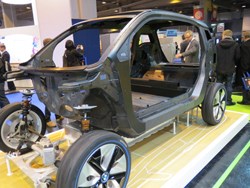JEC Europe 2013: And on the second day, the snow melted
A relatively rare European snowstorm brought much of the continent to a halt on the first day of the JEC Europe 2013 show. But the show went on . . .

The JEC Europe 2013 trade show, being held this week in Paris, got off to an auspicious beginning with a rare and dramatic snow storm on Day 1 that shut down much of Europe and kept some exhibitors and many attendees either at home, stuck in an airport or stranded at a train depot. All the same, enough composites professionals slogged through the ice and snow to make the first day successful, and sun on the second day banished much of the moisture. CW editors were among the attendees and offer some highlights.
In the Innovation Awards corner of the hall, the big attraction has been the award-winning carbon fiber passenger cell of the forthcoming all-electric BMW i3 car (see photo). Featuring SGL Group (Wiesbaden, Germany) carbon fiber produced in the U.S., and due on the market later this year, the i3 represents the first production vehicle to use carbon fiber in the passenger cell and deserved the attention it received. The question looming over the i3 has been what the body panels would be manufactured of. Official word is scarce, but injeciton molding machine maker ENGEL reports that it has sold two large machines to BMW for use in its Leipzig, Germany, facility "to manufacture lightweight components for car body shells." The car is not identified, but if one reads the tea leaves, and understands that the Leipzig plant is being used for primary asembly of the i3, then it's probably not unfair to assume that the i3 body panels will indeed be plastic.
Carbon fiber manufacturer Hexcel (Stamford, Conn., USA) held a press conference on Day 1 and reviewed the role its materials are playing on the Airbus A350 XWB, which is more than 50 percent composites by weight and expected to fly for the first this summer. Hexcel's HexPlay, HexTow and Acouti-Cap products are used variously in the A350's fuselage cockpit, fuselage, vertical tail and horizontal stabilizer, wing covers and spars, wing leading and trailing edges, center wing box, belling fairing and other parts. All told, said Hexcel officials, each A350 XWB represents $4 million in revenue from composite materials. Equally, if not more, interesting was Hexcel's introduction of HiTape UD, a dry carbon fiber for automatic placement applications and out-of-autoclave vacuum infusion processing. Hexcel says it's targing the material to aerostructures applications and exhibited on its stand a demonstration panel molded by Spirit AeroSystems (Wichita, Kan., USA) using the new HiTape UD product (see photo).
Radius Engineering (Salt Lake City, Utah, USA) got some attention on its stand for the 7m/23-ft carbon fiber multispar flap molded in one shot using the same qualified resin transfer molding (SQRTM) process, which provides autoclave-like consolidation outside of the autoclave. The flap, which Radius says is designed (but not necessarily destined for) an Airbus A320, is made with Cytec 977-2 prepreg and molded in a compression molding machine built by Radius. The tool features aluminum mandrels in the core. Additional pressure, per the SQRTM process, is provided also by resin injected around but not into the fabric by a Radius injection system.
JEC Europe wraps up on Thursday, March 14.
Related Content
Bladder-assisted compression molding derivative produces complex, autoclave-quality automotive parts
HP Composites’ AirPower technology enables high-rate CFRP roof production with 50% energy savings for the Maserati MC20.
Read MoreMFFD thermoplastic floor beams — OOA consolidation for next-gen TPC aerostructures
GKN Fokker and Mikrosam develop AFP for the Multifunctional Fuselage Demonstrator’s floor beams and OOA consolidation of 6-meter spars for TPC rudders, elevators and tails.
Read MoreSmartValves offer improvements over traditional vacuum bag ports
Developed to resolve tilting and close-off issues, SmartValves eliminate cutting through vacuum bags while offering reduced process time and maintenance.
Read MoreGKN Aerospace, Joby Aviation sign aerostructures agreement
GKN Aerospace will manufacture thermoplastic composite flight control surfaces for Joby’s all-electric, four-passenger, composites-intensive ride-sharing aircraft.
Read MoreRead Next
VIDEO: High-volume processing for fiberglass components
Cannon Ergos, a company specializing in high-ton presses and equipment for composites fabrication and plastics processing, displayed automotive and industrial components at CAMX 2024.
Read MoreDeveloping bonded composite repair for ships, offshore units
Bureau Veritas and industry partners issue guidelines and pave the way for certification via StrengthBond Offshore project.
Read MoreAll-recycled, needle-punched nonwoven CFRP slashes carbon footprint of Formula 2 seat
Dallara and Tenowo collaborate to produce a race-ready Formula 2 seat using recycled carbon fiber, reducing CO2 emissions by 97.5% compared to virgin materials.
Read More





















